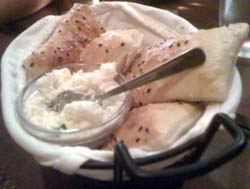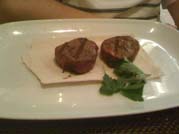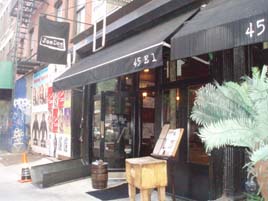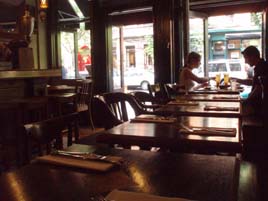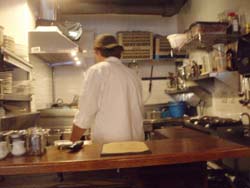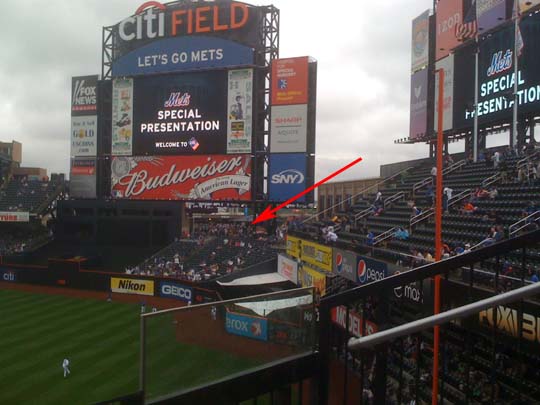
Note: Click here for a more recent review of SHO Shaun Hergatt.
During the two years that the restaurant SHO Shaun Hergatt was under construction, there must have been a thousand times when Chef Hergatt or his investors wondered if they were doing the right thing.
SHO is a luxury French restaurant that makes no compromises—none. It’s in the Financial District, where in my working life there has never been a successful fine dining restaurant, except for steakhouses. To be sure, there haven’t been many attempts. But luxury French dining is a tough bet in any neighborhood. Did I mention we’re in a recession? 
Then there’s the name. Shaun Hergatt is a fine chef, but he doesn’t have a New York footprint: his last outing here was as Gabriel Kreuther’s deputy at Atelier. The obscure Big O in “SHO” is the logo for the Setai, a $154 million, 166-unit condo conversion on Broad Street, just steps away from the stock exchange, where apartments are priced between $815,000 and $4,425,000 [details here].
Despite the long odds against it, Hergatt and his backers have opened the restaurant they dreamed of. We can only hope that the public takes as kindly to it as we did. This is the most ambitious cuisine and the most refined service New York has seen since The Modern and Gilt in 2005–2006. Those with keen memories will recall that both were unfairly panned in the Times.
 The space is stunning. You enter the luxurious Setai lobby, ride an elevator, walk past a long bar, then traverse a long corridor with wine walls on either side. and finally reach the dining rooms, appointed in soft browns and deep reds.
The space is stunning. You enter the luxurious Setai lobby, ride an elevator, walk past a long bar, then traverse a long corridor with wine walls on either side. and finally reach the dining rooms, appointed in soft browns and deep reds.
The two dining rooms are separated by a partition, so that each one feels small and intimate. Hergatt’s large, immaculate kitchen is open, but behind a heavy glass barrier, so that it is seen but not heard. There is also a more casual dining space at the other end of the wine corridor, which was empty on our visit, but will be used for breakfast and lunch.
Not a penny was spared to build this place, but it is tasteful and serene, not ostentatious or overdone.
At dinner, the menu is $57 for two savory courses, or $69 with dessert. With amuse courses taken into account, this is about $20 less than what the meal is worth. In an interview, Hergatt observed that the median income of downtown residents is $250,000, and they’ve all got to eat. Still, the restaurant will need to attract diners from other neighborhoods. As Amanda pointed out at Eater, Corton proves that “people have no problem spending money on excellent food right now. It just better be excellent.”
SHO Shaun Hergatt is excellent. It is better than excellent. On the strength of one meal, it is the best new restaurant to have opened in New York in at least three years. We do realize that everything can change if diners don’t warm up to the place, but the owners haven’t made any compromises yet, and we assume they won’t rush into them anytime soon. On a Saturday evening, the restaurant was half full, which is not bad on a day when the Wall Street area used to be barren.
On the prix fixe menu, there is a choice of ten appetizers and ten entrées, only a few with supplements. The presentation and cooking techniques are obviously French, but many dishes are accented with Asian ingredients. (The chef himself is Australian.)


We started with three canapés, any one of which would have qualified as an amuse-bouche in many restaurants. The beggar’s purse with caviar and sour cream, topped with gold leaf (above left, rear) was staggeringly good. The amuse itself (above right) was a blizzard of ingredients, including a tiny shrimp, served on a porcelein shell, and that sitting on a bed of salt flecked with ground peppers.


The Red Chili and Coconut Milk Glazed Quail (above left) was the only dish of the evening that struck me as underwhelming. It was a perfectly satisfying dish, but a rather simple concept compared to everything else we were served. Double Duck Consommé (above right) offered a rich broth and a raviolo filled with chicken and truffles.


Yogurt Marinated Poussin (above left) was wonderful, and I should note that the portion was double what is shown here; two extra pieces of chicken came out of the kitchen in an extra serving bowl. Veal Tenderloin (above right) was fork-tender and served with a luscious, foamy sauce.


The cheese course (above left) was more than generous: five French imports, all of which I’d happily eat again. We also loved pastry chef Mina Pizarro’s Rhubarb Tart with ginger cremeux and lychee sorbet (above right).
 Naturally, there were petits-fours, including macaroons that exploded with sweet filling when we bit into them.
Naturally, there were petits-fours, including macaroons that exploded with sweet filling when we bit into them.
The portions here are arguably a bit dainty, but counting the various amuses you’re getting six courses for the price of three. At $69, this is one of the least expensive luxury fixed-priced menus in the city, and right now it is one of the best.
On the wine list, bargains are harder to come by. Most bottles are in three figures. The mostly-French list bottoms out at $55, and I believe there were only two choices at that level, with many more options in the $70–80 range. After consulting with the sommelier, we chose one of $55 bottles (2005 Thierry Germain Saumur Champigny) and were deeply satisfied. The top of the list is a magnum of 1953 Château Petrus at $15,000; the most expensive single bottle I saw was $8,000.
The service was practically flawless, with broths and sauces applied table-side and finger bowls delivered after each course in case we’d picked up quail or chicken bones with our hands (we hadn’t). Warm, house-made breads came with two contrasting soft butters, each in its own dome-covered dish. At one point, I looked up and saw that the truffle butter had been replaced with a fresh serving, even though we’d used only half of it.
There was a slight hint of over-eagerness. One runner seemed keen to figure out whether we wanted the cocktail list or the wine list; he should just leave both. The instant I picked up the wine list, a server appeared to ask if I wanted assistance. I said I would in a few minutes, after I’d looked through it. After what felt like 30 seconds, the sommelier appeared. But given the ambition of the project, one can understand their desire to please, and it shone through time after time. They even emailed us the next day to ask how we had enjoyed our visit.
A report of one visit can hardly be definitive, and we make no claims that it is. We sampled just one-fifth of the menu. Things could change dramatically if the restaurant becomes a hit, or if the customers don’t appear and it has to retrench. We can only say that this meal was very close to the best that can be had in New York.
SHO Shaun Hergatt
Food: ***½
Service: ***½
Ambiance: ***
Overall: ***½
 Tuesday, June 30, 2009 at 04:39PM
Tuesday, June 30, 2009 at 04:39PM  Tomorrow, Frank Bruni reviews Bar Artisanal, Terrance Brennan’s cheese-themed brasserie that replaced the doomed Trigo.
Tomorrow, Frank Bruni reviews Bar Artisanal, Terrance Brennan’s cheese-themed brasserie that replaced the doomed Trigo. Bar Artisanal,
Bar Artisanal,  Terrance Brennan in
Terrance Brennan in  Review Preview
Review Preview 






























